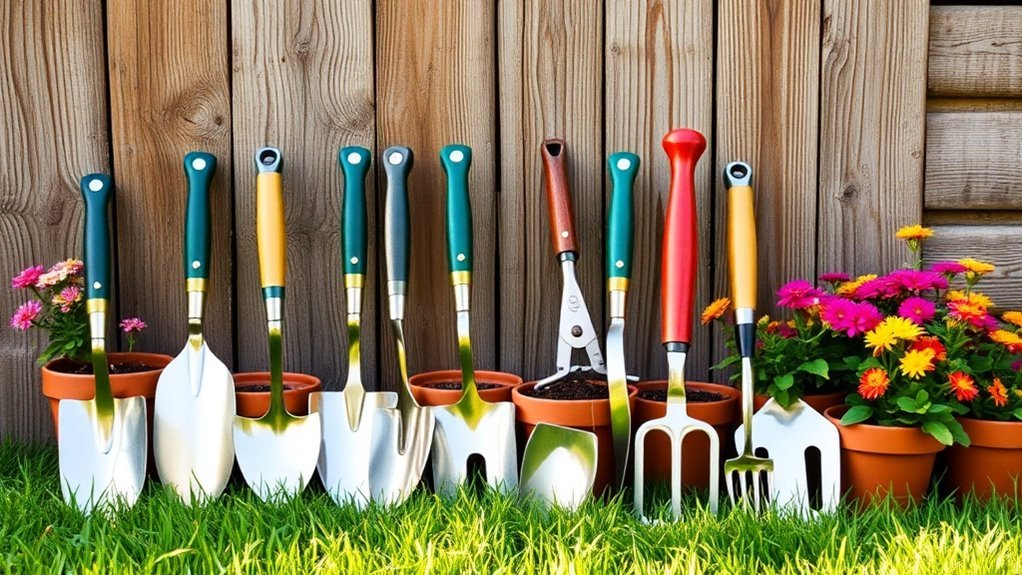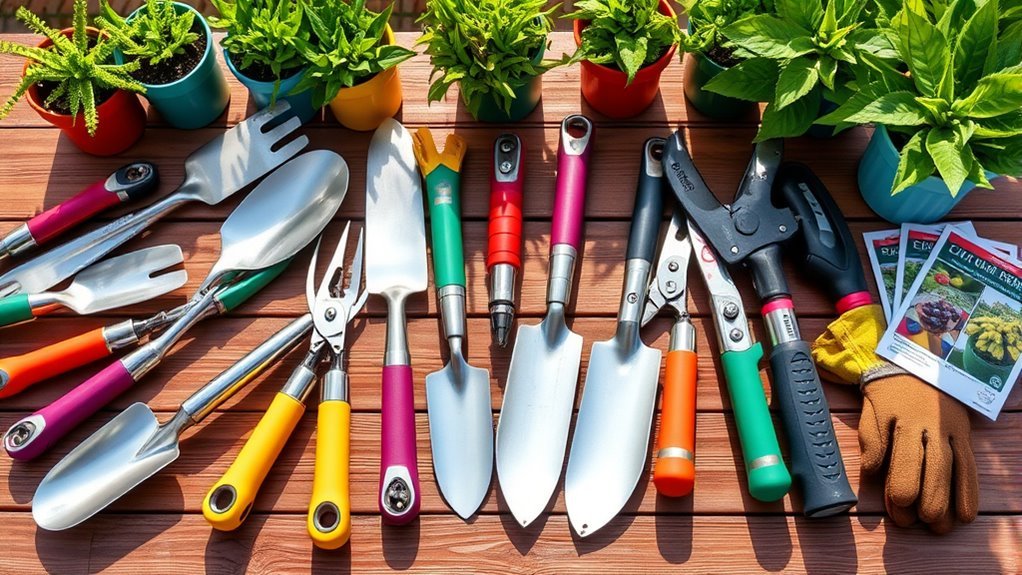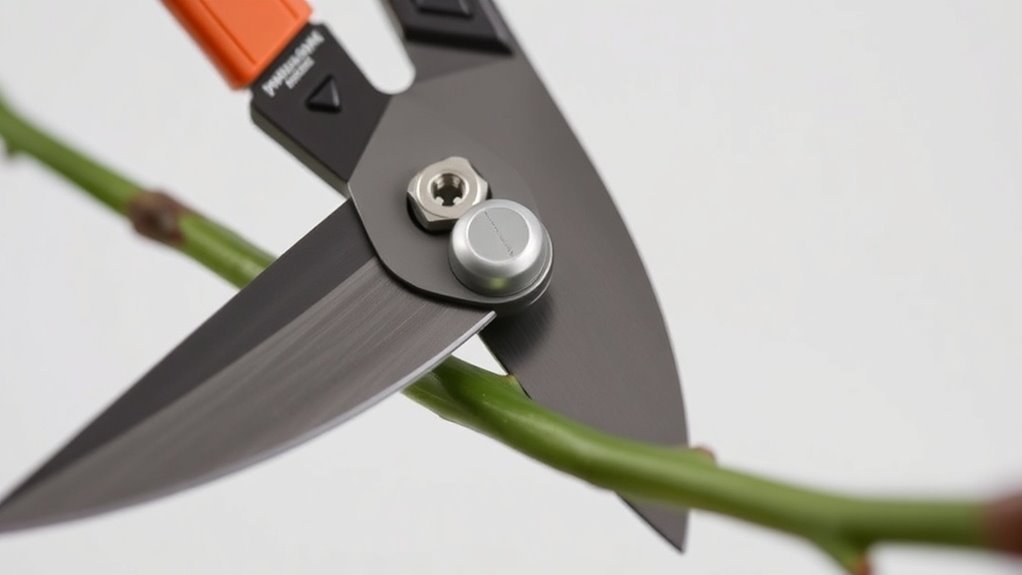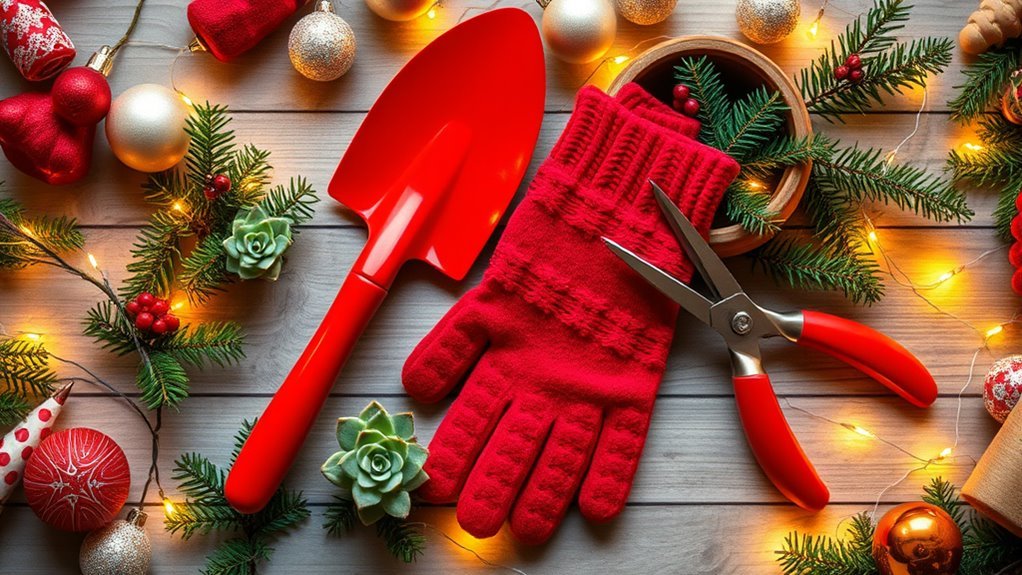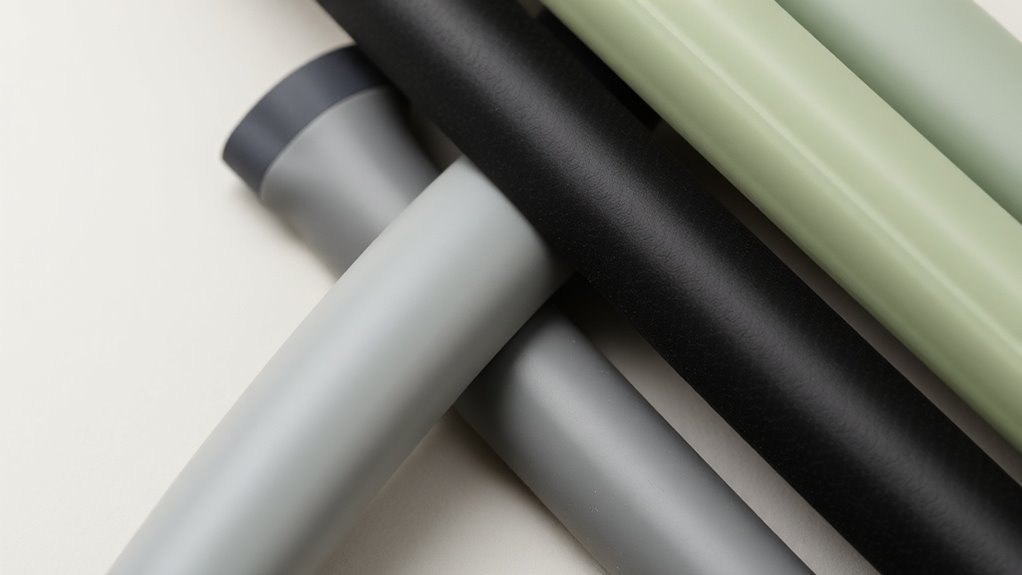Mulching Tools and Their Benefits
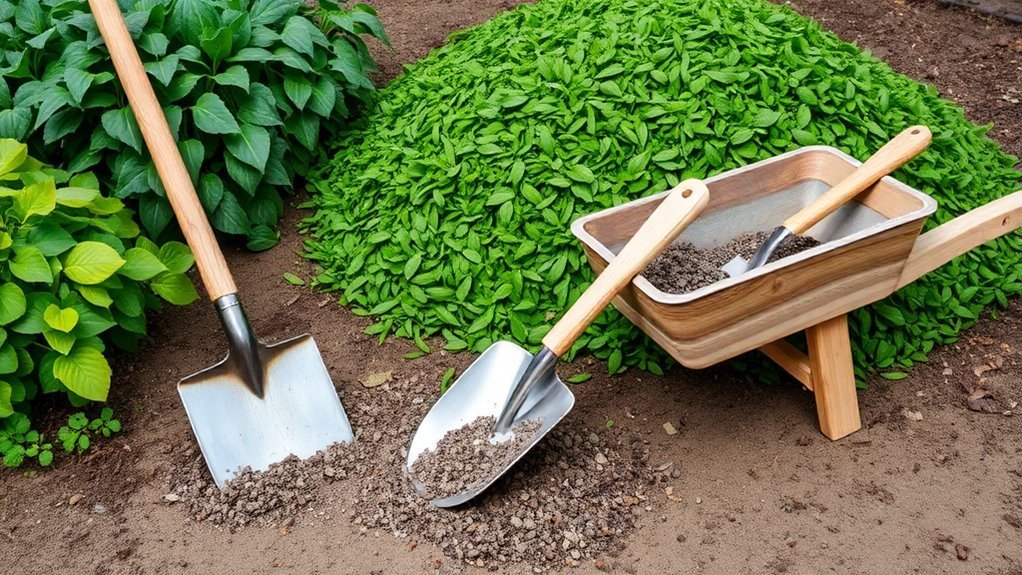
Mulching tools are essential for any gardener who wants to improve plant health and reduce maintenance time. By using tools like wheelbarrows and mulch spreaders, you’ll enhance efficiency while applying mulch. These tools help retain moisture, regulate soil temperature, and suppress weeds, benefiting both your garden and the environment. Investing in quality equipment guarantees better results and long-lasting use. There’s even more to discover about how mulching tools can transform your gardening experience.
Key Takeaways
- Proper tools like shovels and rakes improve efficiency, enabling smooth mulch spreading and reducing physical strain for gardeners.
- Mulch spreaders and chippers are essential for even application and efficient processing of large debris in extensive garden areas.
- Selecting quality, durable tools ensures longevity, saves cost over time, and enhances overall mulching effectiveness and garden aesthetics.
- Organic mulching tools help enrich soil health, promote moisture retention, and reduce weed growth, contributing to a thriving garden ecosystem.
- Effective mulching practices save time on maintenance and improve environmental benefits by minimizing erosion and conserving water resources.
The Importance of Mulching in Gardening
When you think about cultivating a thriving garden, mulching mightn’t be the first thing that comes to mind, but it plays an essential role.
Mulching helps retain moisture in the soil, which means less frequent watering for you. It also regulates soil temperature, protecting your plants from extreme heat or cold. Additionally, it suppresses weed growth, saving you time and effort in maintenance.
As organic mulch breaks down, it enriches the soil with nutrients, promoting better plant health and growth. Moreover, it can prevent soil erosion during heavy rains. Furthermore, using the right pressure in sprayers can enhance the efficacy of applying mulch products, ensuring an even distribution and optimal coverage.
Types of Mulching Tools
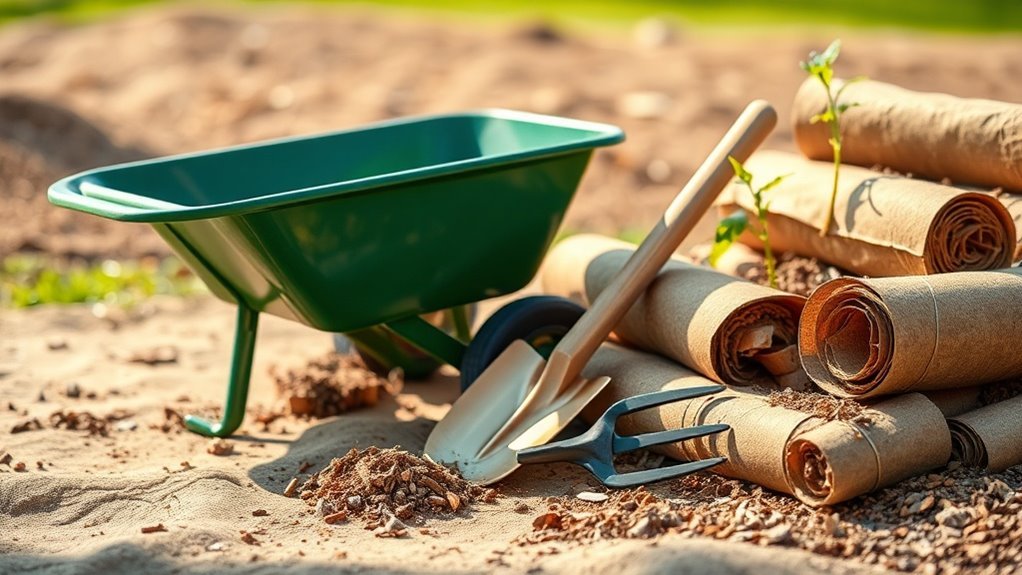
Mulching tools come in various types, each designed to make your gardening experience more efficient and effective.
For instance, you might consider a mulch spreader, which allows you to evenly distribute mulch across your garden beds, saving time and effort.
If you’re dealing with larger areas, a wheelbarrow can be invaluable for transporting heavy bags of mulch.
For smaller projects, a hand-held mulch rake can help you neatly arrange mulch around plants without disturbing the soil.
You could also use a landscape fabric tool to help lay down barrier materials before applying your mulch.
Ultimately, a garden fork or cultivator can assist in mixing mulch into the soil, providing added benefits for your plants.
Choose the right tools for your specific needs!
Traditional Tools for Mulching
When it comes to traditional mulching, you’ll find a variety of tools designed for different types of mulch.
From pitchforks to shovels, each tool offers unique advantages, especially when you prefer manual methods.
Let’s explore how these classic tools can enhance your gardening experience.
Types of Traditional Tools
Gardeners often rely on a variety of traditional tools to effectively apply and manage mulch in their landscapes.
Shovels and spades are essential for moving bulk mulch, allowing you to scoop and spread it where needed. Rakes help you level and distribute the mulch evenly, ensuring that every area gets the right coverage.
Wheelbarrows are invaluable for transporting mulch from piles to garden beds, making the process more efficient. For finer adjustments, hand trowels and garden forks can assist in incorporating mulch around plants.
Additionally, garden gloves protect your hands while you’re working with mulch. Each of these tools plays a significant role in making your mulching tasks easier and more effective as you nurture your landscape.
Tools for Different Mulches
Choosing the right tools for different types of mulch can greatly enhance your gardening efficiency. Here’s a handy overview of traditional tools that suit various mulching materials:
| Mulch Type | Recommended Tool | Purpose |
|---|---|---|
| Wood Chips | Rake | Evenly spread and level mulch |
| Straw | Pitchfork | Lift and distribute easily |
| Grass Clippings | Spreader | Even application without clumps |
| Pine Needles | Garden Fork | Break up clumps and aerate soil |
Using the appropriate tools for your specific mulch not only saves time but also helps maintain the health of your garden. By implementing these suggestions, you’ll make your mulching tasks more efficient and effective.
Advantages of Manual Methods
While many may opt for motorized equipment, manual methods using traditional tools for mulching offer distinct advantages that shouldn’t be overlooked.
First, using hand tools like pitchforks, shovels, or wheelbarrows gives you a deeper connection to your garden. You can pay attention to the soil and plants, ensuring they’re healthy and free from pests.
Plus, manual methods are quieter and more environmentally friendly since they don’t rely on fossil fuels. You’ll save on energy costs and maintenance, too.
Additionally, manual methods can provide a great workout, helping you stay active while improving your garden.
Ultimately, embracing traditional mulching tools can enhance both your gardening experience and the quality of your landscape.
Advanced Mulching Equipment
Advanced mulching equipment can transform your gardening experience by streamlining the process and enhancing the precision of your work. You’ll save time and effort, allowing you to focus on other important tasks within your garden. From powerful chippers to efficient spreaders, these tools make it easier to achieve that perfect layer of mulch.
| Equipment Type | Key Feature | Best For |
|---|---|---|
| Chipper | Shreds branches | Large debris |
| Mulch Spreader | Even application | Large areas |
| Leaf Shredder | Reduces leaf volume | Composting |
| Edger | Clean edges | Flower beds |
| Soil Cultivator | Preps soil | Planting |
Investing in advanced mulching equipment can lead to healthier plants and a thriving garden!
How Mulching Tools Work
Mulching tools are designed to make your gardening tasks easier and more efficient. They work by breaking down organic materials like leaves, grass clippings, and wood chips into smaller pieces.
When you feed these materials into a mulcher, sharp blades chop and shred them, creating a fine mulch that can be spread easily across your garden beds.
Some mulching tools, like chop-and-drop mowers, allow you to leave clippings directly on the lawn, enriching the soil as it decomposes. Others, like hand-held mulchers, help with smaller areas or specific projects.
Benefits of Using Mulching Tools
Using mulching tools offers a host of advantages that can greatly enhance your gardening experience. First, they save you time by efficiently breaking down materials for mulching, allowing you to focus on other tasks. Additionally, they optimize soil health by promoting moisture retention and encouraging beneficial microorganisms.
Here’s a quick overview of the benefits:
| Benefit | Description | Impact on Gardening |
|---|---|---|
| Time-Saving | Quick processing of materials | More time for planting |
| Soil Enhancement | Improves moisture retention | Healthier plants |
| Weed Control | Reduces weed growth | Less maintenance |
| Aesthetic Value | Provides a polished look | Inviting garden space |
Using mulching tools not only streamlines your process but also leads to a thriving garden. Keeping your tools in good condition is crucial for achieving year-round gardening success.
Environmental Impact of Mulching
While you might primarily see mulching as a gardening technique, its environmental impact is equally significant. When you apply mulch, you’re not just enhancing your garden’s aesthetics; you’re also promoting soil health and reducing erosion.
By retaining moisture, mulch lessens the need for frequent irrigation, conserving water for your plants and the environment.
Moreover, organic mulches break down over time, enriching the soil with nutrients that support local ecosystems. They also suppress weeds, which helps maintain biodiversity.
Tips for Choosing the Right Mulching Tools
Consider the tools you’ll need to achieve the benefits of mulching effectively. Choosing the right tools guarantees your mulching process is smooth and efficient. Here are a few tips to help you make the right decision:
- Assess Your Garden Size: If you have a large area, consider a bulk mulcher or a garden cart for transport. For smaller spaces, hand tools may suffice.
- Pick the Right Material: Decide on organic mulch, like wood chips or straw, or inorganic options like rubber. Each serves different purposes.
- Check Tool Durability: Invest in quality tools that can withstand the elements and frequent use. A sturdy wheelbarrow and sharp shovel make a big difference!
With these tips, you’ll find the right tools to enhance your mulching experience.
Questions
Can Mulching Tools Be Used for Non-Garden Applications?
Yes, you can use mulching tools for non-garden applications. They’re great for tasks like shredding leaves or lawn waste for composting and can even help with landscaping projects, saving time and effort in cleanup.
How Do I Maintain My Mulching Tools?
To keep your mulching tools in tip-top shape, clean them after each use, sharpen blades regularly, and store them in a dry place. A stitch in time saves nine, ensuring they last longer!
What Materials Are Best for Mulching?
For mulching, consider organic materials like straw, grass clippings, wood chips, or shredded leaves. These options break down over time, enriching your soil while suppressing weeds, keeping your garden healthy and thriving throughout the season.
Are Electric Mulching Tools Eco-Friendly?
Yes, electric mulching tools are eco-friendly. In fact, studies show they produce 50% less carbon emissions than gas-powered options, making them a sustainable choice for your landscaping needs while helping the environment.
Can I Make Homemade Mulching Tools?
Yes, you can make homemade mulching tools! Using old lawn mowers or even DIY cylinder shredders can work well. Just verify they’re safe to operate, and you’ll have efficient mulching tools without spending a dime.
Conclusion
In the garden of life, mulching tools are your trusty companions, much like the sword to a knight. By choosing the right tools, you’ll not only enhance your garden’s beauty but also nurture the environment. Remember, every layer of mulch you spread is like a new chapter in your gardening story—bringing growth, sustainability, and joy. So, gear up and commence on this enriching journey; your garden (and Mother Nature) will thank you for it!

